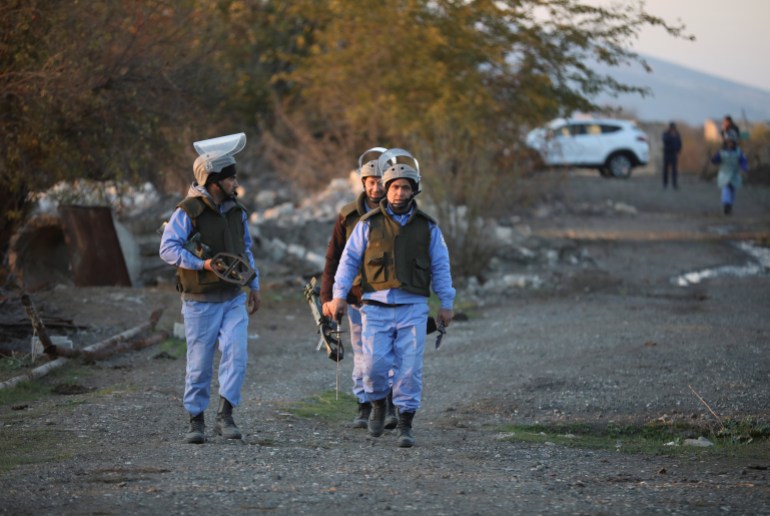Nagorno-Karabakh: Land still laced with mines, year after war
Several people have been killed and injured as de-mining agencies say lack of resources slows efforts to clear weaponry.

Baku, Azerbaijan – A year after intense fighting between Armenia and Azerbaijan over Nagorno-Karabakh, the territory is still so heavily laced with mines and unexploded weaponry that it could take more than 10 years to be fully cleared.
Over the past year, thousands of munitions have been removed but de-mining agencies say a lack of resources and insufficient information are complicating the clean-up operation.
Keep reading
list of 4 itemsAre Azerbaijan and Armenia ready to improve relations?
Armenia accuses Azerbaijan of ethnic hatred at UN court
How fragile is the ceasefire between Armenia and Azerbaijan?
Halo Trust, a humanitarian group that helps countries recover after conflict, is working alongside other groups to clear areas under ethnic Armenian control, while Azerbaijan’s operation is being carried out by the government-run Azerbaijan National Agency for Mine Action (ANAMA).
As well as a large number of landmines across both sides, Halo Trust says the biggest challenge on Armenian-held territory is cluster munitions, which scatter submunitions or bomblets over a wide area.
They have found and destroyed almost 2,000 cluster munitions since the end of the war in November last year, but suffer from a lack of funding. They have 150 staff members against the required 250.
A survey by the Trust found that 68 percent of inhabited settlements either had cluster munitions or evidence of their use.
The group told Al Jazeera it is still finding cluster munitions on agricultural land and in areas frequently used by families for picnics.
One Armenian has been killed since the end of the war, while 20 have suffered amputations or life-changing injuries.
The Trust estimates that more than 16 square kilometres (6 square miles) of land are contaminated, with the search likely to continue for at least another four years.
“Cluster munitions have a high failure rate and can cause injuries and fatalities long after war has finished,” said Miles Hawthorn, Halo Trust’s programme manager in Nagorno-Karabakh.
“The most common type found in Nagorno Karabakh has a distinctive pink ribbon, which makes them cruelly attractive to children.”
Mine maps dispute
According to Human Rights Watch, Armenia and Azerbaijan used cluster munitions, which are widely banned under an international treaty, during last year’s war.
Both deny using them, but accuse the other of doing so.
For ANAMA, the biggest and most time-consuming challenge comes from locating landmines due to inefficient recording of their whereabouts.
With a team of more than 600 people in the field, it says it has so far cleared almost 18,000 anti-personnel mines, more than 9,000 other sorts of mines and 23,000 unexploded ordnance, as well as more than 19,000 hectares (47,000 acres) of land.

As part of last year’s peace deal, Armenia handed over a number of mine locator maps. However, according to ANAMA, they are incomplete and are only about 25 percent accurate.
“The biggest question is, are these all the mine maps?” said Samir Poladov, deputy chairman of the board of ANAMA.
“The ones we did receive were inaccurate and incomplete. Many don’t even have information about coordinates, they just have a general drawing of the area with some information and approximate locations, but they are better to have than nothing.”
Baku believes Yerevan could have more mine maps than were turned over last year. However, Armenian analysts and commentators say they do not exist.
Historic conflict
Armenia and Azerbaijan, two former Soviet republics, fought for six weeks from September last year over Nagorno-Karabakh in a conflict that killed more than 6,500 people – mostly soldiers.
In November 2020, Armenian Prime Minister Nikol Pashinyan signed a ceasefire agreement that granted Azerbaijan control of parts of Nagorno-Karabakh, as well as adjacent territories that had been occupied by Armenians since the first Karabakh war in the 1990s.
During the first conflict, forces from both sides laid landmines across the area, rendering swaths of the territory hazardous. An assessment by the United Nations and the United States at the time found that more than 100,000 landmines had been planted.
According to estimates by ethnic Armenian authorities in Nagorno-Karabakh, landmine explosions killed 180 people and injured 507 in the 1990s – what they claim is the highest number of landmine accidents per capita in any region of the world.
The problem was compounded by the second war, yet Azerbaijan is keen to push ahead with clearances so those who were displaced during the first war can return. For decades, they have been living in temporary accommodation.
Poladov said some people, desperate to see their homeland for the first time since the 1990s, returned before the area had been secured. As a result, there have been 60 civilian accidents, including two deaths.
Explosions also injured five de-miners and killed two Azerbaijani journalists and a local government official.
Years-long clearing effort ahead
While visiting the newly-regained territories still requires government permission, ANAMA is running a mine risk education campaign alongside UN children’s agency UNICEF to raise awareness of the dangers.
More than 600,000 Azerbaijanis fled Nagorno-Karabakh and the surrounding districts during the first war, between 1988 and 1994; the country has one of the world’s largest populations of internally displaced people per capita.

Although the government is planning a number of smart cities to help them return, Deputy Foreign Minister Elnur Mammadov told Al Jazeera that it could take 10 to 12 years for the area to be fully cleared of hazardous weapons.
It is thought the first Azerbaijanis will be able to return to live in Nagorno-Karabakh by the end of this year or early next year.
The use of anti-personnel mines is a violation of international law, but neither Armenia nor Azerbaijan has signed the 1997 Mine Ban Convention to eliminate their use. Both say they are unwilling to stop their use until the other does.